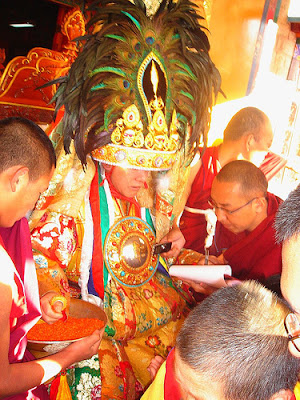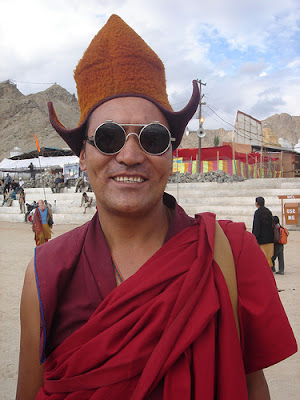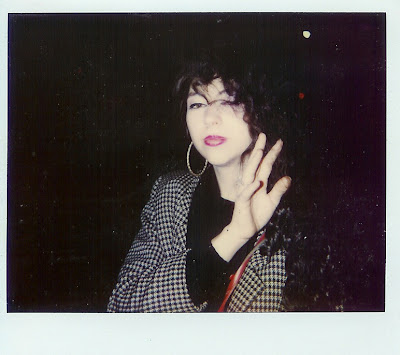Went down to the crossroads
The Spirit World via Kathmandu, Nepal
Long -term Siren watchers (shout out to C Drake, Tim Makins, Jayanthi, George, Carter, Sarasvati, KulluKid and Martin! in the house) know of my standing fascination with the nexus of human and divine.
-term Siren watchers (shout out to C Drake, Tim Makins, Jayanthi, George, Carter, Sarasvati, KulluKid and Martin! in the house) know of my standing fascination with the nexus of human and divine.
That is, spiritual embodiment/channelling/possession/incarnation of the human body, in its
myriad forms; from the semi-theatrical devotional (Bharatanatyam and other devotional dances) to current folk phenomena (Nepal's "Buddha Boy") to ritual incarnation traditions (Nepal's Kumari and Tibet's Tulku reincarnation system - HH Dalai Lama being the best current example).
I'm going to blame it all on my youthful fascination with anthro
-filmmaker Maya Deren, who did extensive work with the Haitian Vodouns, and wrote the seminal book about that belief system, Divine Horsemen.
This was one reason Hinduism always made so much sense to me, intuitively. How could God be completely separate, outside of and apart from us? Hinduism (and Tibetan Buddhism, among others) has this great ongoing tradition of living humans embodying the divine. They walk among us! (In fact, in Hinduism and Buddhism, we already are god, we just have to realize it. But I digress.)
Fortunately I've been able to track down, witness and photograph many manifestations of these various traditions - the Tibetan State Nechung Oracle at Dhar amsala (my photo below), Newar Astamatrika masked dance and its attendant "possession" rituals, Bhaktapur's ferocious NavaDurga dancers (photos forbidden there, though), Theyyam ritual god dances of North Kerala, Nepal's Ram Bomjom (the so-called Buddha Boy) back when he was under the tree in Bara district in southern Nepal, the Thiksey Monastery oracle (who danced waving swords on a 3-storey ledge and threw chhang on me) and dinner with (as well as blessings from) 2 of the 3 Kathmandu Kumaris, just to name a few.
amsala (my photo below), Newar Astamatrika masked dance and its attendant "possession" rituals, Bhaktapur's ferocious NavaDurga dancers (photos forbidden there, though), Theyyam ritual god dances of North Kerala, Nepal's Ram Bomjom (the so-called Buddha Boy) back when he was under the tree in Bara district in southern Nepal, the Thiksey Monastery oracle (who danced waving swords on a 3-storey ledge and threw chhang on me) and dinner with (as well as blessings from) 2 of the 3 Kathmandu Kumaris, just to name a few.
There is a Hindu concept of the teertha, which means (in one interpretation) "meeting place" or crossroads . People who are into sacred geometry, vaastu, feng shui and architecture study the bricks-and-mortar manifestations of these teerthas. I'm more interested in the walking ones.
And the (never-ending) quest continues.
This poorly-written article from the Mangalorean is the first I've heard of a Dakshina Kannada (southern Karnataka) tradition known as Bhootaradhana, or "honouring the ghosts and spirits."
The rituals, costumes and traditions seem to be close to that of North Kerala's Theyyam, which makes sense because they are in a geographically adjoining area. (My photo of Bhagavati Theyyam in Payyanur, above.)
The origin of the cult can be traced from ancestor worship, mother goddess, serpent and trees are incorporated. (Mangalorean photo at right.) There are certain spirits originated from Hindu  God Shiva who sends the Bootas or Ganas to earth and ask them to receive offerings from human beings.
God Shiva who sends the Bootas or Ganas to earth and ask them to receive offerings from human beings.
...The Bhootas are those spirits which once long back in time used to be in blood and flesh like any human being but nevertheless they were endowed with special and extra-human powers to do and undo things as per their will.... The event is called Bhootaradhane or Bhoota Kola. The season of Bhootaradhane begins usually by the first week of February which also signals the arrival of summer. The Bhootaradhane of various bhootas might go up to May 15. The first couple of bhootas to arrive on the scene are Kallurti and Panjurli.... Regional Resources Centre at MGM College Udupi has an entire library of audio and video and documentary evidence of the various bhootas in Dakshina Kannada and the neighboring Kasargod district in Kerala.
If anyone out there has more information about this tradition, or (even better) has ever witnessed a Bhootaradhane festival, I would love to hear about it.
And, if anyone has a correction or clarification about the Hindu (or any other) tradition to share - please do so, politiely. I am certainly open to corrections, but be nice. After all I am just a gori, and at a genetic disadvantage. The only stuff like this my people do is snake-handling and speaking in tongues (and we don't get to wear cool costumes). The Old Testament god doesn't approve of people looking too good.




















